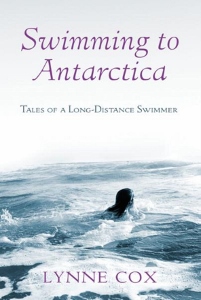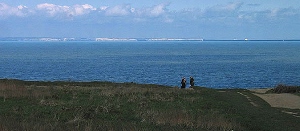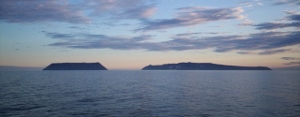Cold, Colder, Coldest…
Author: Lynne Cox
 You’re allowed a cap, goggles and a standard swimsuit. That’s all you get if you want to attempt an official swim across the English Channel. And don’t even think about one of those fancy, insulated, buoyant body suits that all the Ironmen and women wear, they’re not allowed. Given the strong currents, water temperatures in the low sixties (°F) and the fact that it’s 21 miles from England to France, only the toughest swimmers in the world even attempt such a feat. It’s the Mount Everest of swimming. Somehow, Lynne Cox found her calling when just a teen and managed to successfully swim the Channel on her first attempt in 1972 at age 15, setting a world record in the process. She repeated the feat one year later. Taking full advantage of her natural ability to tolerate cold water swimming, she went on to complete a host of other challenging swims around the world, many of them for the first time by any aquatic biped. In 2004, she wrote of her exploits in Swimming to Antarctica.
You’re allowed a cap, goggles and a standard swimsuit. That’s all you get if you want to attempt an official swim across the English Channel. And don’t even think about one of those fancy, insulated, buoyant body suits that all the Ironmen and women wear, they’re not allowed. Given the strong currents, water temperatures in the low sixties (°F) and the fact that it’s 21 miles from England to France, only the toughest swimmers in the world even attempt such a feat. It’s the Mount Everest of swimming. Somehow, Lynne Cox found her calling when just a teen and managed to successfully swim the Channel on her first attempt in 1972 at age 15, setting a world record in the process. She repeated the feat one year later. Taking full advantage of her natural ability to tolerate cold water swimming, she went on to complete a host of other challenging swims around the world, many of them for the first time by any aquatic biped. In 2004, she wrote of her exploits in Swimming to Antarctica.
She begins her story by telling of how she got her start on a swim team in southern California. She wasn’t one of the stars, but was consistently the only kid who seemed to enjoy swimming in the nastiest weather. Cox went on to swim the 26 miles across the Catalina Channel with her teammates, she being the only one who seemed to get stronger the further they swam. With the help of incredibly supportive parents, coaches and teammates, she moved on to the English Channel and other even grander challenges.
“Some four hundred yards down river my hand hit something else. Instinctively, I turned to see what it was: it was a dead rat with one eye missing. A sudden current had carried it down and soon there were a dozen dead rats bobbing around me, eyes missing, heads gnawed away.”
After almost dying while swimming in a sewage and rat infested Nile river distance race in Cairo, Cox chose to pursue somewhat more sanitary goals. She encountered dolphins in Cook Straight in New Zealand, fierce storms in the Strait of Magellan in Chile, large sharks off the Cape of Good Hope in South Africa and icebergs in Glacier Bay in Alaska – and these are just the adventures she includes in the book.
The highlight of the book and what may well be the most impressive feather in her cap, was her attempt to swim from Little Diomede Island to Big Diomede Island at 65° of latitude in the Bering Sea in 1987, crossing both the International Date Line and the Soviet-US border in the process. Following a decade of diplomatic efforts, she almost singlehandedly convinced the governments of the two hostile countries to allow her to attempt the swim, although none of the officials involved thought she had much of a chance of completing the 2.4 mile crossing in 38°F water.
Having swum in some of the nastiest waters of the six inhabited continents, her eyes turned to the only continent missing from her list. If you assume that the seas around Antarctica are as cold as it gets, you’d be right, but such things do not deter this woman. Despite her entirely normal appearance she goes where few others dare to travel, much less swim. The book finishes with her truly astounding attempt to swim more than a mile from a tourist boat to the shore of mainland Antarctica in 32°F water, wearing only a standard suit, cap and goggles.
“Before and after these workouts, I’d hide behind a bush and take my core temperature using a rectal thermometer, the only way to get an accurate reading after immersion in cold water.”
In her addition to the gripping descriptions of her worldwide natatorial exploits, Cox covers plenty about the physiology of cold water exposure, having served as a guinea pig for numerous scientists during her efforts. In fact, many of her swims were completed while “wearing” a 20 foot long rectal probe to monitor her core temperature.
Before I started reading this book, I was skeptical that writing about long distance swimming could really be that interesting. Yet, I was repeatedly impressed with Cox’s ability to generate plenty of dramatic heft out of a never ending combination of frigid, wet waves. Her descriptions of cold beyond words are remarkably vibrant and exhilarating, eliciting plenty of goose bumps from this reader. She also excels at bringing her passion to the page, providing much insight into what motivated her to become the queen of cold water swimming.
There are plenty of adventure and extreme sports books out there and I haven’t read most of them, but it’s hard for me to imagine any of them topping Swimming to Antarctica. Cox’s almost naïve combination of joy, determination and irrationality make for truly thrilling reading. Highly inspiring from beginning to end. Enthusiastically recommended with a warm blanket, a comfy pair of slippers and a hot cup of tea.
– D. Driftless
English Channel photo by Rolf Süssbrich/Bering Strait photo by Dave Cohoe
Read Dave’s review of another Lynne Cox book, Grayson.
- Best Non-Fiction of 2016 - February 1, 2017
- Little Free Library Series — Savannah - May 22, 2015
- Little Free Library Series — Wyoming - November 30, 2014




Leave A Comment